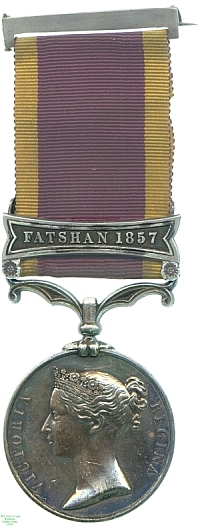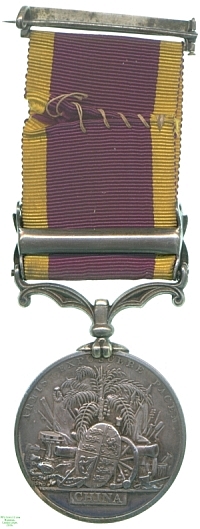
Obverse, a bust of Queen Victoria

Reverse, a collection of war trophies including a royal shield below palm tree

Obverse, a bust of Queen Victoria |

Reverse, a collection of war trophies including a royal shield below palm tree |
Increasing competition from the USA and France for Chinese trade concessions, against a background of extreme Chinese reluctance to co-operate with British trading interests after the First Opium War, led Britain to demand new trading concessions of China in 1854 to secure its `most favoured nation' status. China rejected this demand, and resentment on the ground eventually came to a boil over the seizure by Chinese authorities of a Hong Kong steamer, the Arrow, which the British claimed as a breach of their rights. In retaliation British forces seized the fort of Guangzhou (Canton), with help from US naval vessels, but were driven out of the city when its people and soldiery ignored their governor's order not to resist. Reinforcements for the British were soon sent from India, although slowly because of the concurrent First War of Indian Independence (usually known as the Indian Mutiny).
Upon their arrival with now-allied French forces what was to be a three-year war was renewed in earnest.
In the interval between the initial expulsion from Guanzhong and the renewal of the campaign on land, action in the war was entirely naval, and included the destruction of most of the local Chinese fleet in two battles, one of which was fought in Fatshan Creek (Foshan) in May 1857.
This medal is unnamed, and the recipient cannot be identified, but the bar for the battle at Foshan tells us that he was a sailor or a marine. Lester Watson purchased the medal at some point before 1928.